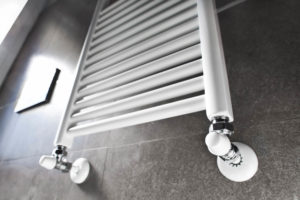During terrible winters a residence with a comfortable temperature always welcomes you to stay and enjoy the evening. Heating systems hence are now required in every area of your home, and your bathroom is no exception.
Bathroom heaters are practical, inexpensive, simple to operate, and important winter additions. When shopping for a bathroom heater, there are a few things to consider such as layout, cost space, and more. So, it is necessary to research the bathroom-specific heaters available and determine which type is best suited for your home.
But trying to select from the diverse pool of heaters can be a difficult decision. So, continue reading to understand what kind of model would suit you best.
Contents
Key Takeaways
- Bathroom heaters are essential for maintaining comfort, preventing moisture-related issues, and reducing heating bills in your bathroom during winter.
- Choose between manual and thermostatic heating based on the bathroom’s frequency of use and temperature fluctuations.
- Consider different types of bathroom heaters, such as radiators, heated towel rails, and underfloor heating, based on your budget, preferences, and space availability.
Why Do You Need a Bathroom Heater?
A cold, wet bathroom is unpleasant and a breeding ground for infections and mould. The last thing you would want in the morning is to enter an unhealthy environment.
Bathroom heating is hence crucial but requires a different, specialized heating solution. This is where bathroom heaters come in.
They are special devices that prevent mirrors from fogging up and keep the air dry. They also prevent moisture and odour buildup and reduce your heating bills.
Additionally, they boost your overall health through improved circulation.
Note: Bathroom heat lamps are made to withstand the dampness of the bathroom.
Manual Vs Thermostatic Heating: What to Choose?
Manual heating
This is the most basic method of controlling your home’s heating. The heater is a manual valve and operates similarly to a regular water tap. You can adjust the bathroom’s temperature by turning the valve on and off.
The only disadvantage of manual heating is that it requires constant monitoring. You may have to ensure that the bathroom temperature is neither too hot nor too cold. This is best suited for:
- A less frequently used bathroom
- A location with substantial low temperature
Thermostatic heating
This heater works with a Thermostatic Radiator Valve (TRV). It has a temperature sensor built in to keep the temperature in the bathroom consistent. This is best suited for:
- Frequently used bathroom
- Areas where the temperature lowers rapidly in the winter

Types of Bathroom Heaters
Based on your budget and preferences, there are three main types of bathroom heaters:
Radiators
Bathroom radiators are the priciest bathroom heating option. However, their elegant design and superior performance often justify the higher cost.
It has a series of electric bars mounted on the wall of your bathroom. The heat is evenly dispersed, ensuring a pleasant and comfortable environment.
Heated towel rails
Heated towel rails are the most trendy and effective and keep your towels soft, heated, and dry. It’s quite a treat to walk out of the shower and onto a warm towel.
It delivers enough heat to warm a small or even a medium-sized bathroom and you can install it on the wall where access to the central heating system is complex.
Underfloor heating
They are also costly, much like radiators. Underfloor heating has the advantage of allowing you to heat the bathroom floor to your preferred temperature. They are becoming more popular as a more modern way of heating.
There are two types of floor heating systems: the dry system which is entirely electric and the wet system which uses hot water from central heating.
Installing an underfloor heating system can be challenging, but it is an opportunity for new construction or remodeling.
Additional bathroom heating options also include:
- Bathroom heater with lights: Bathroom heaters can be combined with a light and a fan in a single device with each function having the option of being turned on or off independently. A bathroom heat light can use one or several bulbs depending on the necessary heat output.Lastly, this fan heater is ideal for a smoky bathroom.
- Electric bathroom heater: This heater does not connect to your existing central heating system. They work mostly by convection, which means that it warms the air in your bathroom. A simple switch controls the convector heater’s heating element. It allows to operate on demand and requires secure storage when not in use.
- Glass panel bathroom heater: This heater is an innovative and stylish addition. They are wall-mounted with concealed brackets for a discrete finish. It is cost-effective and takes very little space. It can be turned on and off as needed and quickly heat a small bathroom.
- Infrared mirror heaterThis acts as a stunning mirror in your bathroom and is perfect for less space and utility. The mirror will never fog up due to the heating element. Additionally, it’s run by a warm radiant glow that heats the walls and tiles of the bathroom. These types of mirrors are also ideal for corridors, living rooms, etc.

How to Choose a Bathroom Heater?
Before deciding on which bathroom heater to buy, it’s critical to understand that a bathroom is divided into four distinct zones. These zones are determined by the risk of water coming into contact with an electrical source.
The 4 zones are:
- Zone 0: The region inside the bath or shower basin may hold water.
- Zone 1: It’s the area right above Zone 0; your bath or shower may be just 2.25m high. It excludes Zone 0.
- Zone 2: It’s the area where Zone 1 enlarged to 0.6m vertically and horizontally around the bath or shower.
- Zone 3: This is the water-free zone.
Now, since you know the basics, it’s time to consider the other factors while choosing a bathroom heater.
Space
Since many bathrooms are compact, it’s vital to utilize the space wisely. Hence, examine your bathroom’s layout. You don’t want a heater that takes up half the room or have it be too close to the zones above. Thus, a wall-mounted heater is preferable. It eliminates most of the issue and take up very little space.
Durability
When it comes to durability and long-term performance, it’s essential to look for the product’s reliability. It is suggested to check:
- The waterproof rating
- The need for maintenance
- Wattage and heating capacity
- Safety features
- Energy efficiency
- Aesthetics
It’s advisable to go with a reputable company that will provide you with after-sale service, and help you with the installation process.
Cost
Bathroom heaters are generally cost-effective as compared to other heaters in your home. If you don’t want to invest in your current home, plenty of cheap temporary fixes are available. You may opt for the less efficient ones and serve the purpose.
Long-term homeowners may wish to consider a modern wall-mounted system that requires less maintenance and offers adequate heating.
Consider installation costs for each heating option. For example:
- A heater that uses central heating would require a plumber to install
- An electric underfloor heating is better installed during construction to avoid costly refurbishments

Safety precautions
While you’re eager to begin enjoying a warmer bathroom experience, it’s also critical to incorporate specific safety considerations. Follow the basic recommendations below, and you can safely enjoy the experience.
GFCI protection
The first safety precaution is using ground-fault circuit interrupter (GFCI) outputs.
If there are tiny changes in current, these safety outlets will immediately switch off the electricity. However, it’s best to get the upgraded version and double-check it with your retailer.
Placement
While installing your bathroom heater, it is critical to pay attention to the zones.
It is also worth noting that, while these bathroom heaters can manage water vapour, they may not be able to handle dense fluid water. As a result, their positioning is crucial.
Prefer wall mounted
Wall-mounted heaters are preferable in bathrooms. If any other system bursts or leaks, you’ll have to pay for a costly new installation. Wall-mounted electric radiators not only don’t have these concerns, but any repairs are quick and easy. So, they minimize the hazards.
Air your bathroom
By ventilating your bathroom, you safeguard the electronics in your heater from wear and tear.
Airing out your bathroom regularly may theoretically be even more efficient, as heat prevents water condensation. If you don’t have any windows, use ventilators.
Wet towel covering
This is the most fundamental tip of all. It is suggested not to cover your radiators with wet towels. Aside from that, putting wet towels over a radiator insulates it and inhibits it from adequately circulating. This will impact convectors, which operate by creating hot air currents and will be significantly less effective.
Heat Pump Source: Reliable Heating and Cooling Solutions
At Heat Pump Source, we take pride in our unwavering commitment to serving the UK with top-tier HVAC solutions. From the efficiency of heat pumps and the cool relief of air conditioning to the warmth of boilers, radiators, and underfloor heating, our dedicated team is always at the forefront of innovation. We understand the unique needs of every household and business, and we strive to provide dependable health and cooling products and services that are tailored just for you. Ensuring your comfort and satisfaction is our utmost priority. Whether you have questions, need guidance, or require support, we’re always here to assist. Please don’t hesitate to contact us; we’re eager to be of service.
Conclusion
An excellent bathroom heater will last longer and come with a warranty, so you won’t have to worry. However, it will be helpful if you remember the above suggestions.
There is a bathroom heater for everyone’s needs. So, if you appreciate those warm mornings in the bathroom, choose one that works best for your setup and say goodbye to early morning chills!
About the Author
At Heat Pump Source, our articles are the product of a collaborative effort among a team of highly skilled HVAC experts. Our dedicated professionals, hailing from diverse backgrounds in heating, ventilation, air conditioning, and refrigeration, contribute their extensive knowledge and experience to every piece of content. This multidisciplinary approach ensures comprehensive coverage. Our commitment is to deliver authoritative, reliable, and tailored advice to meet the unique needs of every household and business across the UK.

